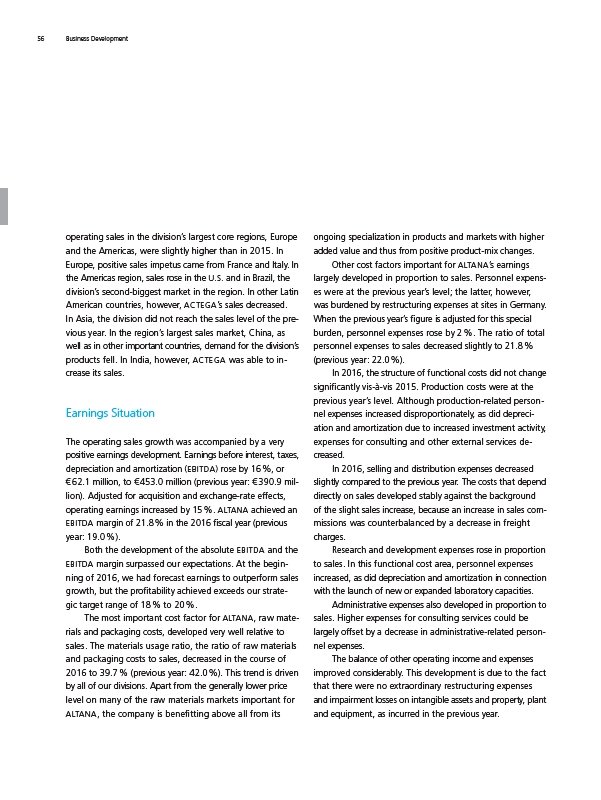
operating sales in the division’s largest core regions, Europe
and the Americas, were slightly higher than in 2015. In
Europe, positive sales impetus came from France and Italy. In
the Americas region, sales rose in the U.S. and in Brazil, the
division’s second-biggest market in the region. In other Latin
American countries, however, ACTEGA’s sales decreased.
In Asia, the division did not reach the sales level of the previous
year. In the region’s largest sales market, China, as
well as in other important countries, demand for the division’s
products fell. In India, however, ACTEGA was able to increase
its sales.
Earnings Situation
The operating sales growth was accompanied by a very
positive earnings development. Earnings before interest, taxes,
depreciation and amortization (EBITDA) rose by 16 %, or
€ 62.1 million, to € 453.0 million (previous year: € 390.9 million).
Adjusted for acquisition and exchange-rate effects,
operating earnings increased by 15 %. ALTANA achieved an
EBITDA margin of 21.8 % in the 2016 fiscal year (previous
year: 19.0 %).
Both the development of the absolute EBITDA and the
EBITDA margin surpassed our expectations. At the begin-
ning of 2016, we had forecast earnings to outperform sales
growth, but the profitability achieved exceeds our strate-
gic target range of 18 % to 20 %.
The most important cost factor for ALTANA, raw mate-
rials and packaging costs, developed very well relative to
sales. The materials usage ratio, the ratio of raw materials
and packaging costs to sales, decreased in the course of
2016 to 39.7 % (previous year: 42.0 %). This trend is driven
by all of our divisions. Apart from the generally lower price
level on many of the raw materials markets important for
ALTANA, the company is benefitting above all from its
ongoing specialization in products and markets with higher
added value and thus from positive product-mix changes.
Other cost factors important for ALTANA’s earnings
largely developed in proportion to sales. Personnel expens-
es were at the previous year’s level; the latter, however,
was burdened by restructuring expenses at sites in Germany.
When the previous year’s figure is adjusted for this special
burden, personnel expenses rose by 2 %. The ratio of total
personnel expenses to sales decreased slightly to 21.8 %
(previous year: 22.0 %).
In 2016, the structure of functional costs did not change
significantly vis-à-vis 2015. Production costs were at the
previous year’s level. Although production-related personnel
expenses increased disproportionately, as did depreci-
ation and amortization due to increased investment activity,
expenses for consulting and other external services decreased.
In 2016, selling and distribution expenses decreased
slightly compared to the previous year. The costs that depend
directly on sales developed stably against the background
of the slight sales increase, because an increase in sales com-
missions was counterbalanced by a decrease in freight
charges.
Research and development expenses rose in proportion
to sales. In this functional cost area, personnel expenses
increased, as did depreciation and amortization in connection
with the launch of new or expanded laboratory capacities.
Administrative expenses also developed in proportion to
sales. Higher expenses for consulting services could be
largely offset by a decrease in administrative-related personnel
expenses.
The balance of other operating income and expenses
improved considerably. This development is due to the fact
that there were no extraordinary restructuring expenses
and impairment losses on intangible assets and property, plant
and equipment, as incurred in the previous year.
56 Business Development